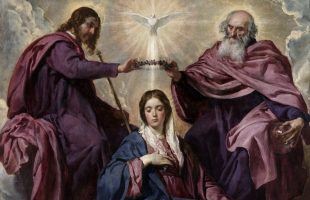
Lesson Objectives
- To understand the relationship between Catholic teaching about Mary and the Scriptural portrayal of Mary.
- To understand the biblical foundations of the Dogma of the Immaculate Conception.
- To appreciate how Catholic belief in the Immaculate Conception flows from the New Testament portrait of Mary as the “New Eve”
I. The Truth About Mary
A. Councils and the Bible
Throughout this course, we’ve been looking at the truths about Mary revealed in Sacred Scripture. We’ve been looking closely at what Scripture has to say about Mary, and - just as important - how Scripture says it.
Since the very beginnings of the Church, the biblical portrait of Mary has been studied and prayed over by popes, bishops, theologians, and saints.
And Mary - who she was, and what role she played in God’s plan for the salvation of the world - was an important topic of discussion and debate in the early Church councils, which were official meetings of bishops under the authority of the pope.
In these councils - such as the Council of Ephesus (in the year 431), the Second Council of Constantinople (553) - we see the Church, guided by the Holy Spirit, interpreting the same Scriptures we have been studying in this course.
The Church’s interpretation of the Scriptures concerning Mary has continued down through the centuries.
The result has been a series of dogmas and doctrines about Mary, all based on the truths revealed in the Scripture texts we’ve been looking at in this course.
In this lesson and in the next, we will take a closer look at these dogmas and doctrines, examining how they are based upon and deepen our appreciation of the biblical portrait of Mary.
B. Dogmas and the Bible
Before we do that, however, we should say a word about the meaning and purpose of dogma and doctrine in Catholic teaching.
Doctrine and dogma are the revealed teachings of Jesus as defined by the Church, which has been entrusted with the Holy Spirit of Jesus to protect it from error and to guide it into all the truth (see John 14:26; 16:12-15; 20:21-22; Acts 2:1-4).
For our purposes here it’s important to keep in mind that doctrine and dogma represent the Church’s definitive interpretation of Scripture, under the guidance of the Spirit.
In the New Testament, the Greek word dogma is used to refer to the "legal claims" of the divine law revealed in the Old Testament scriptures (see Ephesians 2:15). It is also used to refer to the "decisions" reached by the first Church council, held in Jerusalem (see Acts 16:4).
The Council of Jerusalem met to make a definitive interpretation of the Old Testament Scriptures regarding the treatment of non-Jews who convert to Christianity (see Acts 15), a decision in which the apostles were guided by the Holy Spirit (see Acts 15:28).
In the same way, the Church’s doctrines about Mary - about her Immaculate Conception, her status as the "ever-Virgin Mother of God," and her "Assumption" into heaven as "Queen of all things" - represent a definitive interpretation of the whole of Scripture as it relates to Mary’s role in God’s plan for our salvation.
And, as we’ll see, each of these doctrines is based on the biblical portraits we’ve already studied:
• Mary as the new "Eve"
• Mary as the new "Ark of the Covenant"
• Mary as the new "Queen Mother"
Other Lessons
- Lesson One: A Biblical Introduction to Mary
- To understand the basic outlines of the New Testament’s witness to Mary.
- To appreciate how the Old Testament forms the essential background for what the New Testament teaches about Mary.
- To understand “typology” and its importance for reading the New Testament texts concerning Mary.
- Lesson Two: Wedding at Cana, Garden in Eden
- To appreciate the Old Testament symbolism that forms the deep background to the Gospel account of the wedding feast at Cana.
- To understand how Mary is depicted as a “New Eve” in this account.
- To appreciate the importance of the Old Testament marriage symbolism for John’s recounting of the “sign” at Cana.
- Lesson Three: The Ark of the New Covenant
- To see how Mary’s visit to Elizabeth parallels David’s bringing of the Ark of the Covenant to Jerusalem.
- To understand how the book of Revelation uses the startling image of the rediscovered Ark of the Covenant to introduce a vision of the Mother of Christ.
- To understand why the New Testament writers see Mary as the Ark of the New Covenant.
- Lesson Four: Mother Crowned in Glory
- To see the importance of the Queen Mother in the Davidic kingdom of the Old Testament.
- To understand the duties and privileges that came with the position of Queen Mother.
- To see how Mary fills the position of Queen Mother in the kingdom of Christ.
- Lesson Six: The Queen Assumed into Heaven
- To understand the biblical foundations of the Dogma of the Assumption.
- To understand the deep Old Testament symbolism and imagery in Revelation 12, and its relation to Catholic beliefs about Mary.
- To appreciate how the biblical portrait of Mary is reflected and interpreted in the Church’s liturgy.